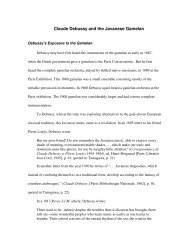Music Preference 1 - Brent Hugh's personal and business web pages
Music Preference 1 - Brent Hugh's personal and business web pages
Music Preference 1 - Brent Hugh's personal and business web pages
Create successful ePaper yourself
Turn your PDF publications into a flip-book with our unique Google optimized e-Paper software.
<strong>Music</strong> <strong>Preference</strong> 33<br />
Considering the importance of social context in determining attitude towards music, priority was<br />
given to maintaining a similarity the experiments' social context to that of real situations (i.e., the<br />
experimental treatments were given at actual concerts in which the performer spoke about the<br />
music before performing <strong>and</strong> in actual school classes in which the performer interacted with the<br />
students before performing). Exact repeatability of performance <strong>and</strong> presentation, which could<br />
have been maintained with videotaped informational presentations <strong>and</strong> recorded performances,<br />
was sacrificed.<br />
Within the several programs given to subgroups of a single group (see Experimental Plan,<br />
below), even more attention was given to keeping performances, presentations, <strong>and</strong> environment<br />
similar. Presentations to subgroups LE, UE, <strong>and</strong> MS were each given on one day. Presentations<br />
to group HS were given over a three-day period. Presentations for group LE were all given in the<br />
same room <strong>and</strong> with the same instrument; similarly for groups UE, MS, <strong>and</strong> HS. The order of the<br />
music played remained the same for all performances for a particular group.<br />
A preliminary study had indicated that there may be a cumulative effect of interaction<br />
between the performer <strong>and</strong> the audience, due to the building of rapport over time (Hugh, 1996).<br />
Therefore, although the informational presentations given to each subgroup vary (see<br />
Experimental Plan, below), the total length of the spoken presentations given to each subgroup<br />
within a group was kept approximately the same. Furthermore, the general types of interaction<br />
(speaking, playing excerpts, involving audience members in presenting plays, involving audience<br />
members in singing or clapping) were kept as similar as possible for subgroups within a group,<br />
although there was some necessary adaptation of material as different treatments were applied to<br />
different repertoire pieces according to the experimental plan for the group.





